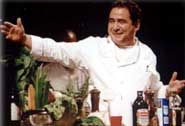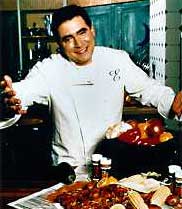Kathleen Collins appeared on The Bat Segundo Show #290.
Kathleen Collins is most recently the author of Watching What We Eat.
Condition of Mr. Segundo: Contending with traumatic cooking show associations.
Author: Kathleen Collins
Subjects Discussed: TK
EXCERPT FROM SHOW:
 Correspondent: I should probably start this conversation off by confessing something to you. I think that Rachael Ray is a bit on the crazy side. She’s not someone who really makes me comfortable. I’m actually quite frightened by her. You know, I don’t find her down-to-earth at all. And I think maybe we can start off by describing how we went from this relatively benign cooking show setup, in which you had a quieter, less frenetic impulse, to this more exhibitionistic cooking show that involves a Jerry Springer-like audience shouting for the EVOO and all that. How did we get from one extreme to the other? Do you have any fundamental observation throughout the course of your meticulous observations?
Correspondent: I should probably start this conversation off by confessing something to you. I think that Rachael Ray is a bit on the crazy side. She’s not someone who really makes me comfortable. I’m actually quite frightened by her. You know, I don’t find her down-to-earth at all. And I think maybe we can start off by describing how we went from this relatively benign cooking show setup, in which you had a quieter, less frenetic impulse, to this more exhibitionistic cooking show that involves a Jerry Springer-like audience shouting for the EVOO and all that. How did we get from one extreme to the other? Do you have any fundamental observation throughout the course of your meticulous observations?
Collins: I do. Although first I have to address your fear of Rachael Ray. Of which I don’t think you’re alone. I can’t remember where I read it. But I heard somebody liken her to Shrek. I don’t know if it was physicality. Or the monsterness. But you’re not alone. I mean, there are people who absolutely adore her. And they’re usually moms. Somebody’s mom who loves her. But otherwise I think, yeah, she can be pretty scary. How we got to that from, let’s say, the home economists of the 1940s and ’50s?
Correspondent: Yeah.
Collins: Long story. I mean, that’s basically what I tried to cover. And it was just a gradual process from the early days of cooking shows where it was all about selling the sponsor’s products. And let’s just use this kitchen space that we have in our studio. Let’s sell this refrigerator. How are we going to fill the time? Well, this is a cheap thing to do. Let’s have some home economists in here and whip something up. Very dry. And then gradually though, they would add some spiciness. There were some shows in the ’50s that had a little entertainment in them. There was Chef Milani out of Los Angeles. And his show was almost slapstick. There was a lot of comedy in it. So for the most part, it was the home ec ladies in the early days. Very, very gradual. Adding entertainment elements. But things didn’t really change until the entertainment aspect really came on with Graham Kerr. The Galloping Gourmet in 1969. At least 1969 in the U.S. Julia Child, everyone will tell you they were in love with her. They were completely entertained by her. But that was not her sole purpose. That was not her purpose at all. She just happened to be extremely charming and lovable. And there’s been no one like her since. So, you know, as soon as the Galloping Gourmet came on the scene and people saw what you could do with the cooking show, it was sort of a light bulb going off. And then other people tried to do it. But none of them for a while. You know, there was a dry spell.
Correspondent: Yeah. But there’s a fundamental difference between Graham Kerr leaping over the divide.
Collins: And leaping over the chair.
Correspondent: Yeah. Leaping over the chair. That is something I can kind of accept. Because I can imagine a friend of mine cooking penne alfredo doing just that.
Collins: (laughs)
Correspondent: I cannot imagine, for example, Rachael Ray, who is bulging her eyes at the camera, holding the utensils in a manner that is completely unnatural — just from the start — and having this thirty-minute, almost exhibitionistic quality to what we’re doing. We move from something that is plausible. Something that is — okay, we’ve got this fourth wall between the television and us. And it’s just plausible for us to have a realistic connection. We can imagine Graham Kerr possibly coming into the kitchen with us.
Collins; That’s true.
Correspondent: But we can’t quite imagine Rachael Ray demanding that we conform to this thirty-minute rigid time. I mean, she’s almost like an HR manager controlling the exact conditions of your employment.
Collins: Yeah, that’s true. I mean, I think a lot of it has to do with the highly produced nature of the show. They have these sets that are just glistening with stainless steel and granite and all the perfect elements that we don’t — many of us don’t have in our homes. Most of us probably don’t have such nice stuff in our kitchens. So we can’t relate to that. And, you know, she doesn’t really cook a meal in front of us. She puts ingredients together in front of us. So it doesn’t look like a real activity. And as for the exhibitionism, I mean, it’s all about personality. I mean, that’s when the Food Network came into being. That’s what they quickly realized was the focal point of every show.
BSS #290: Kathleen Collins (Download MP3)



